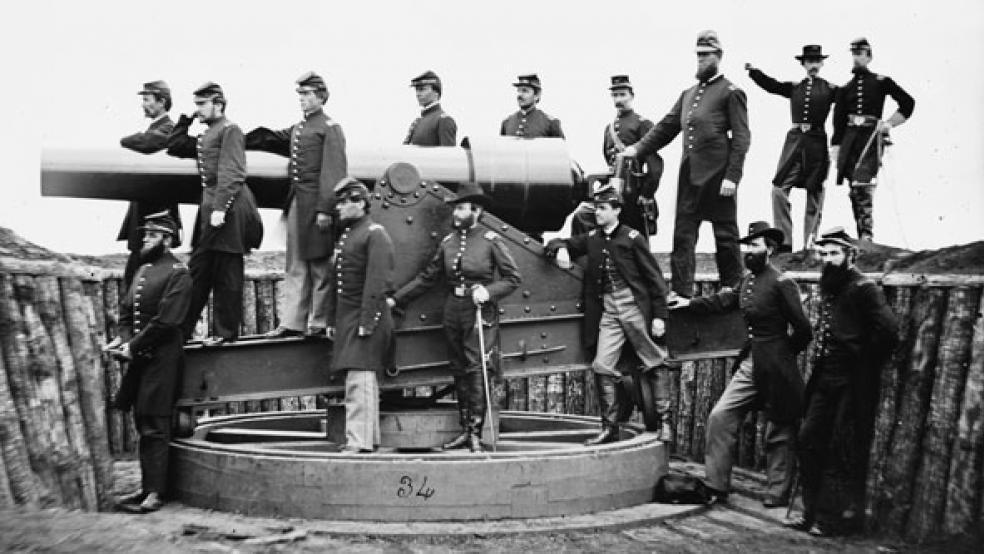One hundred and fifty years ago today, the United States entered into war with itself, embarking on what would become a four-year-long conflict and one of the country’s early major fiscal tests. In 1864, President Lincoln said of the Civil War, “It has produced a national debt and taxation unprecedented, at least in this country.”
Indeed, public debt increased 15 times over between 1961 and 1965. But under Lincoln, the Union was careful to maintain sound fiscal footing. For the first time in the country’s history, Americans would pay federal income taxes. By today’s standards, those 1861 rates seem downright quaint: 3 percent on income above $800 and 5 percent on those living outside the country. The following year the law was revised to levy a 3 percent tax on income beyond $600 and 5 percent on earnings over $10,000. But those quaint rates generated 25 percent of the Civil Wars’ costs, according to Robert Hormats, author of The Price of Liberty, which details the financing of American wars.
At the same time, Lincoln’s Treasury secretary, Salmon P. Chase, oversaw the creation of both the first federal currency, in 1862, and a national banking system, in 1863. A standardized currency enabled the United States to issue $500 million in war bonds, and the banks provided a market for them. “The national banking system was created primarily for the purpose of buying these government bonds to back the issue of national bank notes [currency],” explains Roger L. Ransom, author of several books on the Civil War, including Conflict and Compromise: The Political Economy of Slavery, Emancipation, and the American Civil War.
War Costs Then and Now
Civil War *
Total estimated cost of the Civil War: $4.2 billion (about $84 billion in todayÕs dollars)
Cost as a percentage of GDP in peak year: 11.3 percent (1865)
Total debt at the start of the Civil War: $64.8 million (about $1.296 billion in todayÕs dollars)
Total debt at the start of the Civil War: $2.2 billion (about $44 billion in todayÕs dollars)
Percentage increase in public debt: 1,543 percent
War on Terror
Total estimated cost (as of July 2010): $1.121 trillion
Cost as a percentage of GDP in peak year: 1.2 percent (2008)
Total public debt at the start of the Iraq War: $6.2 trillion
Total public debt today: $14.3 trillion
Percentage increase in public debt: 230 percent
*Costs are guesstimated for inflation based on modern metrics. There is no consensus on how to measure inflation before 1913.
Fast forward a century and a half to see how the country took a somewhat different approach to its finances during the Iraq and Afghanistan Wars. In 2003, just two months after the U.S. invaded Iraq, Congress passed the second round of what have become known as the Bush tax cuts, which lowered income tax rates, as well as levies on investment income (the first was passed in 2001, before 9/11). The unfolding wars were then funded predominantly by assuming higher levels of federal debt, leaving the U.S. today $14.3 trillion in the hole.
“Recent experiences of the U.S. come closer to the Confederate model [deficit financing which led to debilitating inflation], but because financial markets today are far larger and more sophisticated than in 1860, and because people (like the Chinese) were willing to buy and simply hold U.S. bonds without cashing them, the effect of deficit finance was not nearly as inflationary,” says Ransom.
After the Civil War ended, the U.S. government insisted on paying off the war debt – it called in all of the “greenbacks,” according to Ransom, resulting in “the longest deflationary period in American history.” This led to widespread economic tumult, including labor revolts, which culminated with country adopting the gold standard in 1900.
Despite the country’s current deficit problems, the War on Terror* cost only 1.2 percent of GDP at its highest in 2008, according to a 2010 report by the Congressional Research Service. In 1865, by contrast, the northern states spent 11.3 percent of GDP on the Civil War. And the percentage increase in federal debt during the Civil War far outstrips the percentage increase during the Iraq and Afghanistan Wars. The explanation: In the 1860s, the United States economy was smaller and far less developed. As a result, overall productivity was much lower, given that manufacturing was still in its infancy (no assembly line yet), and the majority of the population working in agriculture had a very low per capita output.
It remains to be seen how the U.S. will cope with today’s mountain of war debt. However, the day of reckoning is likely to arrive soon – as the government is set to reach its legal limit on spending in the next couple of months. There are several proposals on the table to deal with the debt, although the final strategy remains unclear. But one thing is sure: Now as in Lincoln’s time, the national debt is “unprecedented.”
* Iraq, Afghanistan and other post-9/11 operations
Related Links:
Fort Sumter in Pictures (National Geographic)
Civil War Anniversary: 13 Questions 150 Years Later (CS Monitor)
Civil War 150 (The Washington Post)


